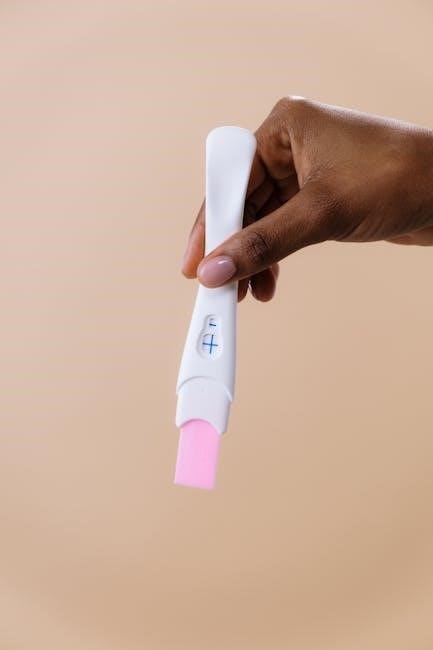Fake positive COVID-19 test results occur when tests incorrectly indicate infection in uninfected individuals, raising concerns about accuracy, public health response, and individual consequences.
Definition and Overview
A false positive COVID-19 test result occurs when a test incorrectly indicates the presence of SARS-CoV-2 in an uninfected individual. This can happen due to contaminated samples, improper test handling, or manufacturing defects. Rapid antigen tests are particularly prone to false positives, with studies showing rates as high as 1.7% in some cases. Such errors can lead to unnecessary isolation, contact tracing, and public health resource strain. Confirmatory testing, such as RT-PCR, is often recommended to verify results. Understanding the causes and implications of false positives is crucial for improving test accuracy and public trust in COVID-19 testing systems.
Implications of False Positive Results
False positive COVID-19 results can lead to overestimation of disease incidence, straining public health systems. Increased demand on contact tracing and isolation measures diverts resources from actual cases. Individuals may experience unnecessary stress, lost income, and social stigma. Public misconceptions about test reliability can erode trust in health authorities and reduce compliance with safety guidelines. Additionally, false positives may lead to inappropriate quarantine measures, disrupting daily life and economic activities. Addressing these challenges requires accurate testing, clear communication, and robust support systems to mitigate the broader societal impacts of false positive results.

Causes of False Positive COVID-19 Test Results
Manufacturing defects, testing conditions outside guidelines, and contaminants like certain drinks can cause false positives, affecting test accuracy and public health responses.

Test Strip Lot Variability and Manufacturing Issues
Manufacturing defects in COVID-19 test strips, such as variability in lots, have been linked to false positive results. Studies indicate specific lots of rapid antigen tests showed higher rates of false positives compared to others. For instance, the Ellume COVID-19 home test was recalled in 2021 due to potential false-positive SARS-CoV-2 results. Laboratory evaluations revealed that certain test strip lots failed to meet accuracy standards, leading to incorrect detections. These manufacturing issues highlight the importance of quality control in test production to ensure reliable outcomes and maintain public trust in testing systems.
Testing Conditions Outside Manufacturer Recommendations
Using COVID-19 tests under conditions not specified by manufacturers can lead to false-positive results. A study by G. Patriquin found that when tests were used outside recommended parameters, accuracy decreased significantly. For example, the Panbio SARS-CoV-2 assay showed increased false positives when certain environmental factors or improper handling occurred. Additionally, using substances like alcoholic or acidic beverages near test strips could contaminate samples. Adhering strictly to manufacturer guidelines is crucial to minimize such errors and ensure reliable test outcomes, as deviations can compromise the integrity of results and lead to unnecessary public health interventions;
Substances Causing False Positives (e.g., Orange Juice)
Certain substances, such as orange juice, have been identified as potential causes of false-positive COVID-19 test results. Studies have shown that acidic or alcoholic beverages can interfere with test strip chemistry, leading to incorrect positive readings. For instance, researchers found that orange juice could trigger false positives in rapid antigen tests due to its acidity. Similarly, other household substances have been implicated in causing erroneous results. These findings highlight the importance of avoiding contact between test samples and external substances to ensure accurate testing outcomes and prevent unnecessary public health measures.

Impact of False Positive Results
False positive results can overestimate COVID-19 incidence, strain contact tracing systems, and lead to unnecessary quarantine measures, causing societal disruption and economic losses.
Overestimation of COVID-19 Incidence
False positive results can inflate COVID-19 case numbers, skewing public health data and policy decisions. This overestimation may lead to unnecessary restrictions and heightened fear among populations.
Increased Demand on Contact Tracing Systems
False positive COVID-19 results place additional strain on contact tracing systems, as each positive test triggers resource-intensive investigations. This surge in cases, though inaccurate, overwhelms health authorities, diverting personnel from genuine outbreaks. Studies suggest individuals with false positives may be less likely to comply with isolation, further complicating tracking efforts. The added workload delays identification of real cases, hindering effective disease control. This highlights the need for accurate testing to prevent unnecessary strain on public health infrastructure and ensure efficient pandemic management. The impact is magnified in regions with limited resources, exacerbating existing challenges in curbing the virus spread.
Public Misconceptions and Behavior Changes
False positive COVID-19 results often lead to public misconceptions, as individuals may mistakenly believe they are infected, fostering unnecessary fear and confusion. This can result in behavior changes, such as voluntary isolation or avoiding social interactions, even when uninfected. Misinformation about test reliability may spread, eroding trust in public health measures. Some individuals, particularly youth, have exploited false positives by using substances like orange juice to simulate positive results, further fueling skepticism. These behaviors highlight the need for clear communication and education to address misconceptions and promote accurate understanding of COVID-19 testing. Public awareness campaigns are essential to mitigate these challenges.

Methods to Identify False Positive Results
Laboratory evaluations and field studies analyze discrepancies between rapid antigen tests and RT-PCR results to confirm false positives, ensuring accurate COVID-19 diagnosis and public health response.
Laboratory Evaluation of False Positives
Laboratory evaluation of false positives involves comparing rapid antigen test results with RT-PCR to confirm inaccuracies. Studies reveal manufacturing defects and testing conditions outside guidelines as key factors. For instance, specific test strip lots and improper handling can lead to false positives. In controlled lab settings, researchers identify substances like orange juice that may cause interference. These evaluations highlight the importance of adherence to manufacturer guidelines and the need for confirmatory testing. Such analyses are crucial for improving test accuracy and reducing misleading outcomes, ensuring reliable COVID-19 diagnosis and public health responses.

Field Studies and Real-World Data Analysis
Field studies and real-world data analysis provide insights into false positive rates in diverse testing environments. A large-scale study involving over 11,000 participants revealed a 1.7% false positive rate for rapid antigen tests compared to RT-PCR results. These studies highlight factors such as testing conditions and substance interference as contributors to inaccurate results. Real-world data also shows that false positives can lead to reduced isolation compliance, with individuals less likely to follow guidelines after receiving misleading results. Such findings underscore the importance of robust testing protocols and public education to mitigate the impact of false positives on public health strategies and individual behavior.

Mitigating False Positive Results
Effective strategies to reduce false positive COVID-19 test results include adherence to manufacturer guidelines, confirmatory testing, and public education campaigns to ensure accurate outcomes and compliance.
Adherence to Manufacturer Guidelines
Adhering to manufacturer guidelines is critical to minimizing false positive COVID-19 test results. Proper handling, storage, and use of test kits according to instructions reduce errors. Ensuring samples are collected correctly and tests are performed within expiration dates is vital. Training personnel and maintaining quality control measures further enhance accuracy. Studies have shown that deviations from recommended protocols, such as improper test strip handling or suboptimal testing conditions, significantly increase false positive rates. Following guidelines ensures reliable results, helping to maintain public trust and effective pandemic response.
Use of Confirmatory Testing (e.g., RT-PCR)
Confirmatory testing, such as RT-PCR, is essential for verifying initial COVID-19 test results, especially when false positives are suspected. RT-PCR, considered the gold standard, offers higher sensitivity and specificity compared to rapid antigen tests. By retesting individuals who receive positive results, healthcare providers can confirm infections and reduce the likelihood of false positives. This approach is particularly important in low-prevalence settings, where false positives may disproportionately affect overall accuracy. Implementing RT-PCR as a follow-up ensures more accurate case reporting and helps mitigate the societal and economic impacts of false positive results.
Public Education and Awareness Campaigns
Public education and awareness campaigns play a crucial role in mitigating the impact of false positive COVID-19 results. By educating individuals about the proper use of testing kits, interpretation of results, and potential sources of false positives, such as certain substances or environmental factors, the likelihood of incorrect test outcomes can be reduced. Clear communication about the limitations of rapid antigen tests and the importance of confirmatory testing helps build trust in public health systems. Additionally, campaigns that emphasize the consequences of false positives, such as unnecessary isolation or resource wastage, encourage responsible behavior and adherence to testing guidelines.

Recent Studies and Findings
Recent studies identify specific test strip lots and substances, like orange juice, causing false positives. A large-scale study found 1.7% false positives in 11,000 participants.
Large-Scale Studies on False Positive Rates
Large-scale studies reveal varying rates of false positives across different COVID-19 tests. One study involving over 11,000 participants reported a 1.7% false positive rate for rapid antigen tests when compared to RT-PCR results. This highlights the importance of confirmatory testing. Another study found that certain test strip lots were linked to higher false positive rates, emphasizing the role of manufacturing quality. These findings underscore the need for rigorous quality control and adherence to testing protocols to minimize false positives and ensure accurate results.
Specific Investigations on Rapid Antigen Tests
Specific investigations into rapid antigen tests (RATs) have identified key factors contributing to false positives. Research indicates that certain test strip lots exhibit higher false positive rates, often linked to manufacturing defects. A study of over 11,000 participants revealed a 1.7% false positive rate for RATs compared to RT-PCR results. Additionally, testing conditions outside manufacturer guidelines, such as improper handling or contaminated samples, can also lead to inaccurate results. These findings emphasize the importance of adhering to testing protocols and ensuring manufacturing quality to enhance the reliability of RATs in COVID-19 detection and public health responses.
False Positives and Isolation Compliance
False positive COVID-19 results can significantly impact isolation compliance, as individuals may receive inaccurate diagnoses. A US study revealed that people with positive home-based test results were 29% less likely to follow isolation recommendations compared to those with negative results. This non-compliance can lead to increased viral spread and public health challenges. Additionally, false positives may cause unnecessary anxiety and economic burden on individuals. Addressing this issue requires improved test accuracy and clear communication about isolation protocols to ensure compliance and mitigate the risks associated with false positive results in the community.

Regulatory and Industry Responses
Regulatory agencies, like the FDA, have issued recalls for COVID-19 tests with high false-positive rates, such as Ellume’s home test. Manufacturers have updated protocols to improve accuracy and reduce errors, ensuring compliance with safety standards and public trust in testing solutions.
Recalls of COVID-19 Testing Kits
The FDA issued a recall of Ellume’s COVID-19 home test in 2021 due to potential false-positive SARS-CoV-2 results. This action highlighted manufacturing defects and quality control issues. Such recalls underscore the importance of rigorous testing and compliance with regulatory standards to ensure accuracy and reliability. Recalls also demonstrate the proactive role of regulatory bodies in addressing public health concerns. These incidents often lead to updated protocols and improved test designs, emphasizing the need for transparency and accountability in the production of diagnostic tools.
Updated Testing Protocols and Recommendations
Regulatory bodies and manufacturers have implemented updated protocols to address false-positive results. For instance, the FDA recommended enhanced quality control measures post-recall incidents. Studies like those by G. Patriquin (2021) highlighted the importance of adhering to manufacturer guidelines to minimize false positives. Updated testing protocols now emphasize pre-test checks and proper sample handling. Additionally, confirmatory testing, such as RT-PCR, is often recommended for positive rapid antigen results to ensure accuracy. These measures aim to reduce errors, improve reliability, and maintain public trust in COVID-19 testing systems. Continuous monitoring and updates remain critical in the evolving pandemic landscape.

Economic and Social Costs
False positives incur economic costs through unnecessary isolation, contact tracing, and lost productivity. Socially, they may lead to stigma, anxiety, and mistrust in public health systems.
Hidden Costs of False Positive Results
A study involving over 11,000 participants revealed that 1.7% received false positive rapid antigen test results, highlighting the hidden costs of such errors. These include unnecessary isolation, financial burdens from repeated testing, and emotional distress for individuals and families. Additionally, false positives can strain public health resources, as contact tracing systems may pursue non-existent cases, diverting efforts from genuine outbreaks. Furthermore, such errors can erode public trust in testing systems, leading to reduced compliance with isolation guidelines and other preventive measures. Addressing these hidden costs requires improved test accuracy and transparent communication to maintain public confidence and behavior.
Ethical Considerations in COVID-19 Testing
False positive COVID-19 results raise significant ethical concerns, particularly regarding public trust and individual rights. Studies show individuals with false positives may be less likely to adhere to isolation guidelines, undermining pandemic control efforts. The psychological impact of erroneous results, including anxiety and stigma, further complicates the ethical landscape. Additionally, the recall of testing kits, such as Ellume’s COVID-19 home test, highlights the need for transparent communication about test limitations. Ethical frameworks must balance the benefits of widespread testing with the risks of false positives, ensuring equitable access to accurate testing while minimizing harm to individuals and communities. This requires ongoing evaluation and improvement of testing protocols to maintain public trust and ethical integrity in pandemic response strategies.
